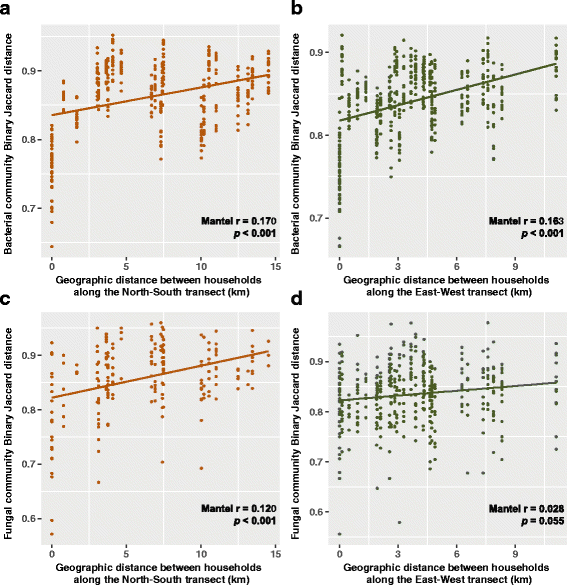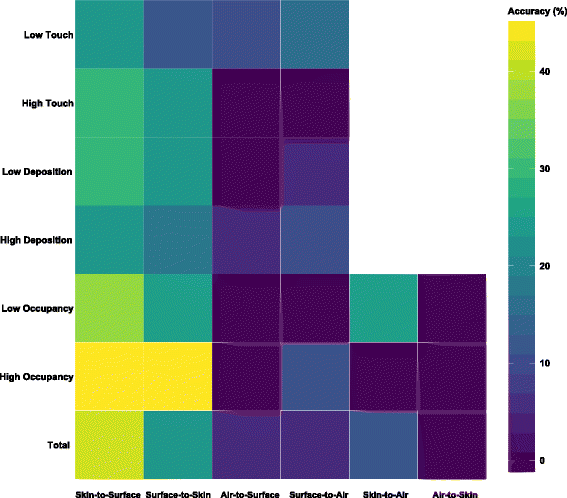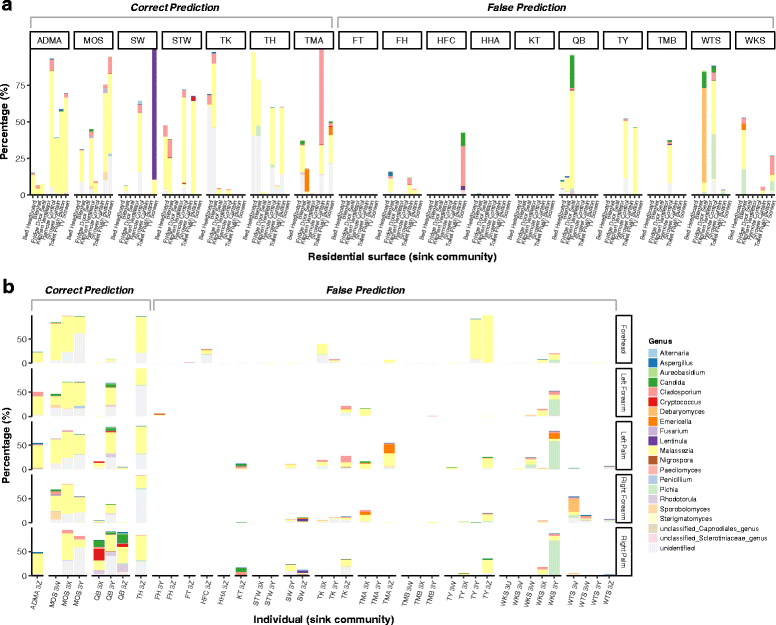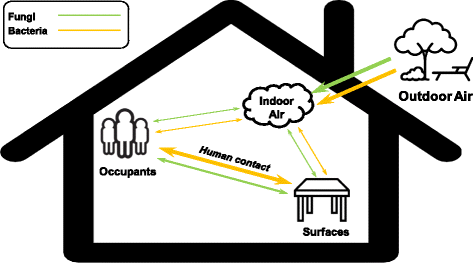City-scale distribution and dispersal routes of mycobiome in residences
- PMID: 28978345
- PMCID: PMC5628474
- DOI: 10.1186/s40168-017-0346-7
City-scale distribution and dispersal routes of mycobiome in residences
Abstract
Background: Pathogenic and allergenic bacteria and fungi within the indoors can bring detrimental health effects on the occupants. We previously studied the bacterial communities found in households located throughout Hong Kong as well as the skin surfaces of the occupants. As a complementary study, here, we investigated the fungal communities (mycobiome) in the same residences and occupants and identified factors that are important in shaping their diversity, composition, distribution, and dispersal patterns.
Results: We observed that common skin and environmental fungal taxa dominated air, surface, and skin samples. Individual and touch frequency strongly and respectively shaped the fungal community structure on occupant skin and residential surfaces. Cross-domain analysis revealed positive correlations between bacterial and fungal community diversity and composition, especially for skin samples. SourceTracker prediction suggested that some fungi can be transferred bidirectionally between surfaces and skin sites, but bacteria showed a stronger dispersal potential. In addition, we detected a modest but significant association between indoor airborne bacterial composition and geographic distance on a city-wide scale, a pattern not observed for fungi. However, the distance-decay effects were more pronounced at shorter local scale for both communities, and airflow might play a prominent role in driving the spatial variation of the indoor airborne mycobiome.
Conclusions: Our study suggests that occupants exert a weaker influence on surface fungal communities compared to bacterial communities, and local environmental factors, including air currents, appear to be stronger determinants of indoor airborne mycobiome than ventilation strategy, human occupancy, and room type.
Keywords: Biogeography; Dispersal potentials; Distance-decay; Indoor built environment; Mycobiome.
Conflict of interest statement
Ethics approval and consent to participate
Ethics approval for subject sampling and publication of data originating from subjects included in this study was granted by the City University of Hong Kong Ethics Committee (reference number 3-2-201312 (H000334)). All subjects provided written consent to release personal and related data for publication as needed.
Competing interests
The authors declare that they have no competing interests.
Publisher’s Note
Springer Nature remains neutral with regard to jurisdictional claims in published maps and institutional affiliations.
Figures






Similar articles
-
Indoor air bacterial communities in Hong Kong households assemble independently of occupant skin microbiomes.Environ Microbiol. 2016 Jun;18(6):1754-63. doi: 10.1111/1462-2920.12889. Epub 2015 Jun 11. Environ Microbiol. 2016. PMID: 25923292
-
Relative and contextual contribution of different sources to the composition and abundance of indoor air bacteria in residences.Microbiome. 2015 Dec 10;3:61. doi: 10.1186/s40168-015-0128-z. Microbiome. 2015. PMID: 26653310 Free PMC article.
-
Dispersal in microbes: fungi in indoor air are dominated by outdoor air and show dispersal limitation at short distances.ISME J. 2013 Jul;7(7):1262-73. doi: 10.1038/ismej.2013.28. Epub 2013 Feb 21. ISME J. 2013. PMID: 23426013 Free PMC article.
-
Topographical and physiological differences of the skin mycobiome in health and disease.Virulence. 2017 Apr 3;8(3):324-333. doi: 10.1080/21505594.2016.1249093. Epub 2016 Oct 18. Virulence. 2017. PMID: 27754756 Free PMC article. Review.
-
Dimensions of biodiversity in the Earth mycobiome.Nat Rev Microbiol. 2016 Jul;14(7):434-47. doi: 10.1038/nrmicro.2016.59. Nat Rev Microbiol. 2016. PMID: 27296482 Review.
Cited by
-
The Seasonal Dynamics and the Influence of Human Activities on Campus Outdoor Microbial Communities.Front Microbiol. 2019 Jul 10;10:1579. doi: 10.3389/fmicb.2019.01579. eCollection 2019. Front Microbiol. 2019. PMID: 31354673 Free PMC article.
-
Critically Appraising the Significance of the Oral Mycobiome.J Dent Res. 2021 Feb;100(2):133-140. doi: 10.1177/0022034520956975. Epub 2020 Sep 13. J Dent Res. 2021. PMID: 32924741 Free PMC article. Review.
-
The Mycobiome in Health and Disease: Emerging Concepts, Methodologies and Challenges.Mycopathologia. 2020 Apr;185(2):207-231. doi: 10.1007/s11046-019-00413-z. Epub 2020 Jan 1. Mycopathologia. 2020. PMID: 31894501 Free PMC article. Review.
-
Type 2-high asthma is associated with a specific indoor mycobiome and microbiome.J Allergy Clin Immunol. 2021 Apr;147(4):1296-1305.e6. doi: 10.1016/j.jaci.2020.08.035. Epub 2020 Sep 12. J Allergy Clin Immunol. 2021. PMID: 32926879 Free PMC article.
-
Season, Vegetation Proximity and Building Age Shape the Indoor Fungal Communities' Composition at City-Scale.J Fungi (Basel). 2022 Oct 3;8(10):1045. doi: 10.3390/jof8101045. J Fungi (Basel). 2022. PMID: 36294610 Free PMC article.
References
MeSH terms
Substances
LinkOut - more resources
Full Text Sources
Other Literature Sources
Medical
Research Materials

